Financial Management Exam: Analysis of WACC, Governance, and CSR
VerifiedAdded on 2023/06/10
|12
|3734
|98
Homework Assignment
AI Summary
This document presents a comprehensive solution to a financial management exam. The first question evaluates the proposition that financial management theory can minimize the weighted average cost of capital (WACC), discussing capital structure theories like pecking order, trade-off, and traditional theories. Question 2 delves into corporate governance, outlining its principles and the roles of stakeholders, alongside the impact of Corporate Social Responsibility (CSR). Question 3 involves calculating Net Present Value (NPV) and Internal Rate of Return (IRR) for investment projects, evaluating the strengths and weaknesses of the IRR method, and exploring risk incorporation. Finally, Question 4 discusses methods to assist managers, including calculating an optimal product and sales mix plan.

24 hours exam
Paraphrase This Document
Need a fresh take? Get an instant paraphrase of this document with our AI Paraphraser
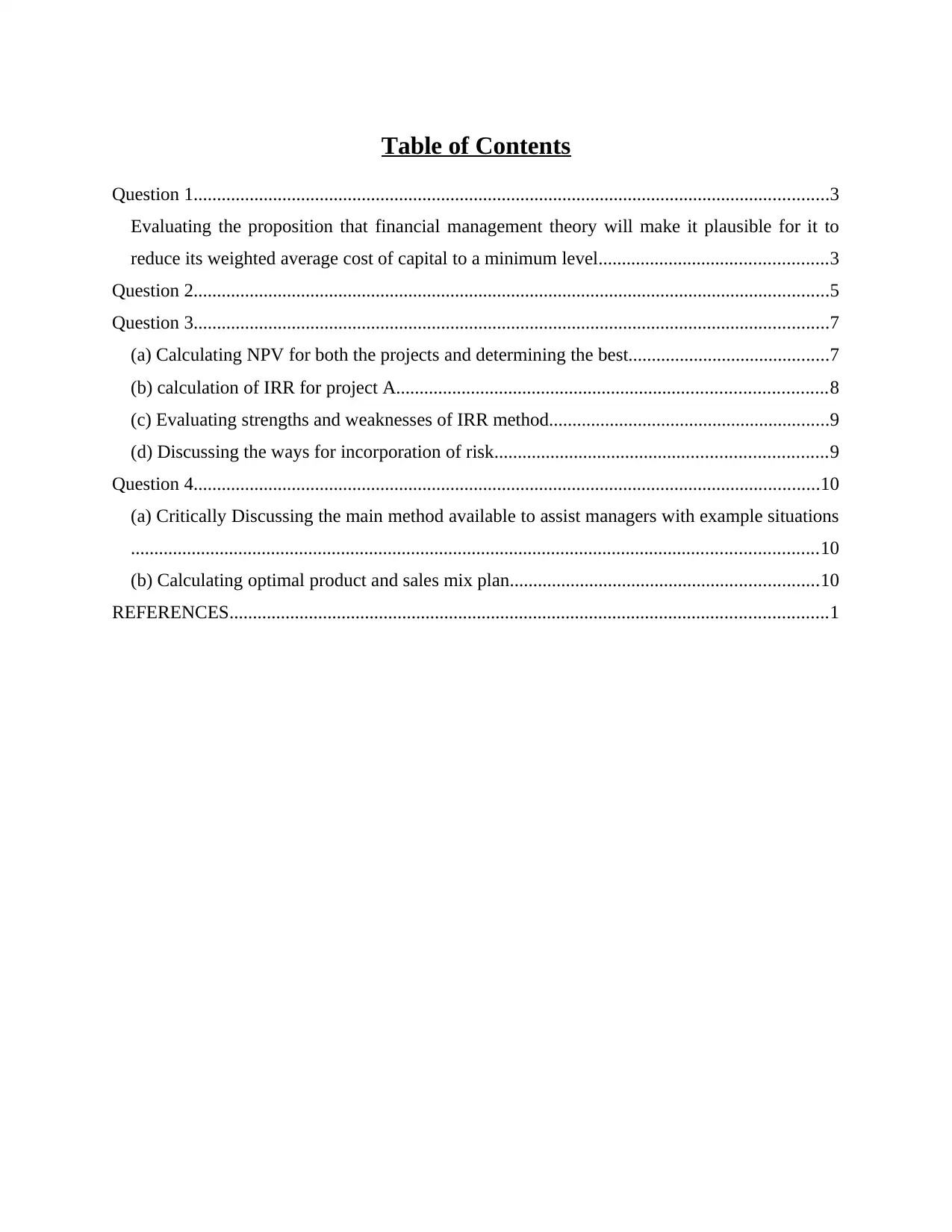
Table of Contents
Question 1........................................................................................................................................3
Evaluating the proposition that financial management theory will make it plausible for it to
reduce its weighted average cost of capital to a minimum level.................................................3
Question 2........................................................................................................................................5
Question 3........................................................................................................................................7
(a) Calculating NPV for both the projects and determining the best...........................................7
(b) calculation of IRR for project A............................................................................................8
(c) Evaluating strengths and weaknesses of IRR method............................................................9
(d) Discussing the ways for incorporation of risk.......................................................................9
Question 4......................................................................................................................................10
(a) Critically Discussing the main method available to assist managers with example situations
...................................................................................................................................................10
(b) Calculating optimal product and sales mix plan..................................................................10
REFERENCES................................................................................................................................1
Question 1........................................................................................................................................3
Evaluating the proposition that financial management theory will make it plausible for it to
reduce its weighted average cost of capital to a minimum level.................................................3
Question 2........................................................................................................................................5
Question 3........................................................................................................................................7
(a) Calculating NPV for both the projects and determining the best...........................................7
(b) calculation of IRR for project A............................................................................................8
(c) Evaluating strengths and weaknesses of IRR method............................................................9
(d) Discussing the ways for incorporation of risk.......................................................................9
Question 4......................................................................................................................................10
(a) Critically Discussing the main method available to assist managers with example situations
...................................................................................................................................................10
(b) Calculating optimal product and sales mix plan..................................................................10
REFERENCES................................................................................................................................1
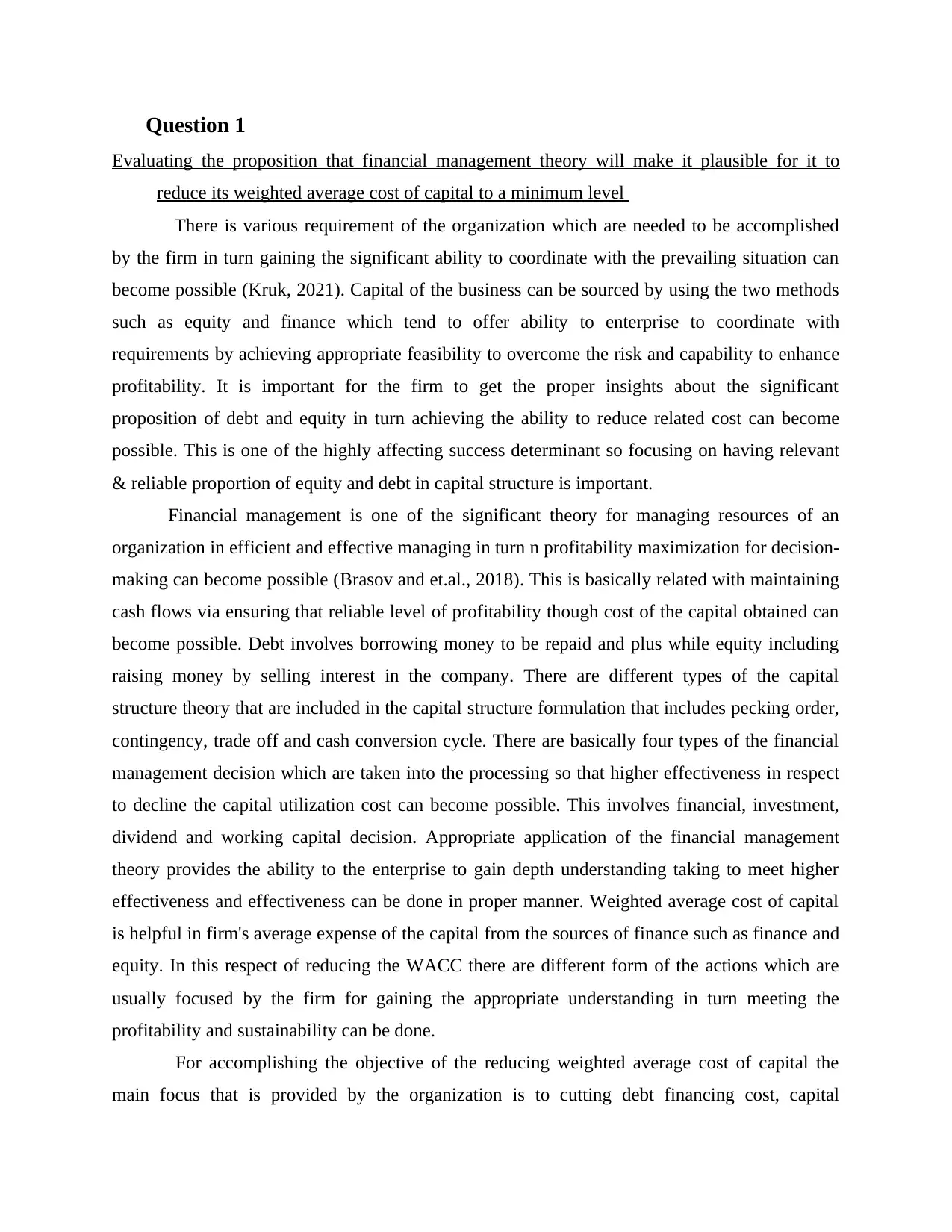
Question 1
Evaluating the proposition that financial management theory will make it plausible for it to
reduce its weighted average cost of capital to a minimum level
There is various requirement of the organization which are needed to be accomplished
by the firm in turn gaining the significant ability to coordinate with the prevailing situation can
become possible (Kruk, 2021). Capital of the business can be sourced by using the two methods
such as equity and finance which tend to offer ability to enterprise to coordinate with
requirements by achieving appropriate feasibility to overcome the risk and capability to enhance
profitability. It is important for the firm to get the proper insights about the significant
proposition of debt and equity in turn achieving the ability to reduce related cost can become
possible. This is one of the highly affecting success determinant so focusing on having relevant
& reliable proportion of equity and debt in capital structure is important.
Financial management is one of the significant theory for managing resources of an
organization in efficient and effective managing in turn n profitability maximization for decision-
making can become possible (Brasov and et.al., 2018). This is basically related with maintaining
cash flows via ensuring that reliable level of profitability though cost of the capital obtained can
become possible. Debt involves borrowing money to be repaid and plus while equity including
raising money by selling interest in the company. There are different types of the capital
structure theory that are included in the capital structure formulation that includes pecking order,
contingency, trade off and cash conversion cycle. There are basically four types of the financial
management decision which are taken into the processing so that higher effectiveness in respect
to decline the capital utilization cost can become possible. This involves financial, investment,
dividend and working capital decision. Appropriate application of the financial management
theory provides the ability to the enterprise to gain depth understanding taking to meet higher
effectiveness and effectiveness can be done in proper manner. Weighted average cost of capital
is helpful in firm's average expense of the capital from the sources of finance such as finance and
equity. In this respect of reducing the WACC there are different form of the actions which are
usually focused by the firm for gaining the appropriate understanding in turn meeting the
profitability and sustainability can be done.
For accomplishing the objective of the reducing weighted average cost of capital the
main focus that is provided by the organization is to cutting debt financing cost, capital
Evaluating the proposition that financial management theory will make it plausible for it to
reduce its weighted average cost of capital to a minimum level
There is various requirement of the organization which are needed to be accomplished
by the firm in turn gaining the significant ability to coordinate with the prevailing situation can
become possible (Kruk, 2021). Capital of the business can be sourced by using the two methods
such as equity and finance which tend to offer ability to enterprise to coordinate with
requirements by achieving appropriate feasibility to overcome the risk and capability to enhance
profitability. It is important for the firm to get the proper insights about the significant
proposition of debt and equity in turn achieving the ability to reduce related cost can become
possible. This is one of the highly affecting success determinant so focusing on having relevant
& reliable proportion of equity and debt in capital structure is important.
Financial management is one of the significant theory for managing resources of an
organization in efficient and effective managing in turn n profitability maximization for decision-
making can become possible (Brasov and et.al., 2018). This is basically related with maintaining
cash flows via ensuring that reliable level of profitability though cost of the capital obtained can
become possible. Debt involves borrowing money to be repaid and plus while equity including
raising money by selling interest in the company. There are different types of the capital
structure theory that are included in the capital structure formulation that includes pecking order,
contingency, trade off and cash conversion cycle. There are basically four types of the financial
management decision which are taken into the processing so that higher effectiveness in respect
to decline the capital utilization cost can become possible. This involves financial, investment,
dividend and working capital decision. Appropriate application of the financial management
theory provides the ability to the enterprise to gain depth understanding taking to meet higher
effectiveness and effectiveness can be done in proper manner. Weighted average cost of capital
is helpful in firm's average expense of the capital from the sources of finance such as finance and
equity. In this respect of reducing the WACC there are different form of the actions which are
usually focused by the firm for gaining the appropriate understanding in turn meeting the
profitability and sustainability can be done.
For accomplishing the objective of the reducing weighted average cost of capital the
main focus that is provided by the organization is to cutting debt financing cost, capital
⊘ This is a preview!⊘
Do you want full access?
Subscribe today to unlock all pages.

Trusted by 1+ million students worldwide
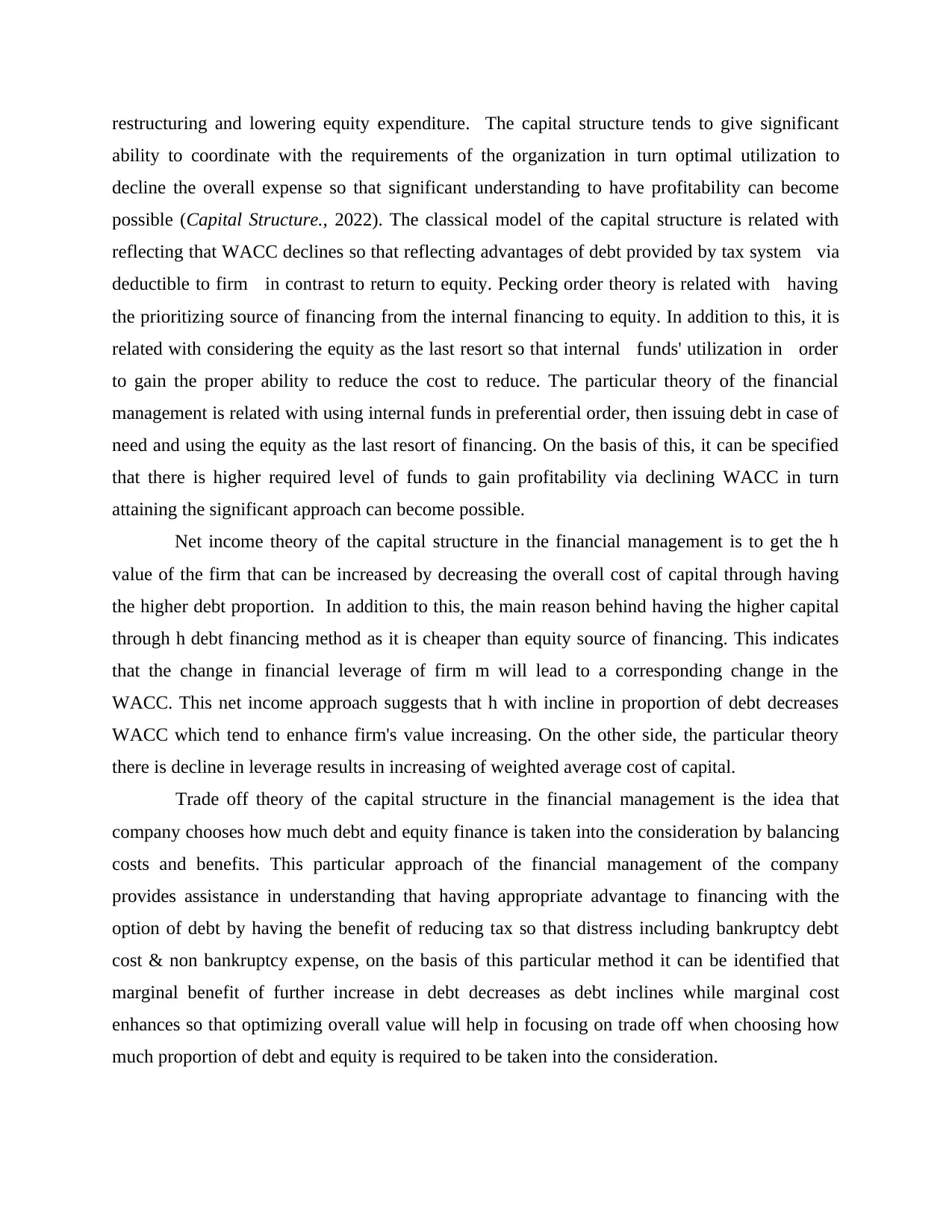
restructuring and lowering equity expenditure. The capital structure tends to give significant
ability to coordinate with the requirements of the organization in turn optimal utilization to
decline the overall expense so that significant understanding to have profitability can become
possible (Capital Structure., 2022). The classical model of the capital structure is related with
reflecting that WACC declines so that reflecting advantages of debt provided by tax system via
deductible to firm in contrast to return to equity. Pecking order theory is related with having
the prioritizing source of financing from the internal financing to equity. In addition to this, it is
related with considering the equity as the last resort so that internal funds' utilization in order
to gain the proper ability to reduce the cost to reduce. The particular theory of the financial
management is related with using internal funds in preferential order, then issuing debt in case of
need and using the equity as the last resort of financing. On the basis of this, it can be specified
that there is higher required level of funds to gain profitability via declining WACC in turn
attaining the significant approach can become possible.
Net income theory of the capital structure in the financial management is to get the h
value of the firm that can be increased by decreasing the overall cost of capital through having
the higher debt proportion. In addition to this, the main reason behind having the higher capital
through h debt financing method as it is cheaper than equity source of financing. This indicates
that the change in financial leverage of firm m will lead to a corresponding change in the
WACC. This net income approach suggests that h with incline in proportion of debt decreases
WACC which tend to enhance firm's value increasing. On the other side, the particular theory
there is decline in leverage results in increasing of weighted average cost of capital.
Trade off theory of the capital structure in the financial management is the idea that
company chooses how much debt and equity finance is taken into the consideration by balancing
costs and benefits. This particular approach of the financial management of the company
provides assistance in understanding that having appropriate advantage to financing with the
option of debt by having the benefit of reducing tax so that distress including bankruptcy debt
cost & non bankruptcy expense, on the basis of this particular method it can be identified that
marginal benefit of further increase in debt decreases as debt inclines while marginal cost
enhances so that optimizing overall value will help in focusing on trade off when choosing how
much proportion of debt and equity is required to be taken into the consideration.
ability to coordinate with the requirements of the organization in turn optimal utilization to
decline the overall expense so that significant understanding to have profitability can become
possible (Capital Structure., 2022). The classical model of the capital structure is related with
reflecting that WACC declines so that reflecting advantages of debt provided by tax system via
deductible to firm in contrast to return to equity. Pecking order theory is related with having
the prioritizing source of financing from the internal financing to equity. In addition to this, it is
related with considering the equity as the last resort so that internal funds' utilization in order
to gain the proper ability to reduce the cost to reduce. The particular theory of the financial
management is related with using internal funds in preferential order, then issuing debt in case of
need and using the equity as the last resort of financing. On the basis of this, it can be specified
that there is higher required level of funds to gain profitability via declining WACC in turn
attaining the significant approach can become possible.
Net income theory of the capital structure in the financial management is to get the h
value of the firm that can be increased by decreasing the overall cost of capital through having
the higher debt proportion. In addition to this, the main reason behind having the higher capital
through h debt financing method as it is cheaper than equity source of financing. This indicates
that the change in financial leverage of firm m will lead to a corresponding change in the
WACC. This net income approach suggests that h with incline in proportion of debt decreases
WACC which tend to enhance firm's value increasing. On the other side, the particular theory
there is decline in leverage results in increasing of weighted average cost of capital.
Trade off theory of the capital structure in the financial management is the idea that
company chooses how much debt and equity finance is taken into the consideration by balancing
costs and benefits. This particular approach of the financial management of the company
provides assistance in understanding that having appropriate advantage to financing with the
option of debt by having the benefit of reducing tax so that distress including bankruptcy debt
cost & non bankruptcy expense, on the basis of this particular method it can be identified that
marginal benefit of further increase in debt decreases as debt inclines while marginal cost
enhances so that optimizing overall value will help in focusing on trade off when choosing how
much proportion of debt and equity is required to be taken into the consideration.
Paraphrase This Document
Need a fresh take? Get an instant paraphrase of this document with our AI Paraphraser
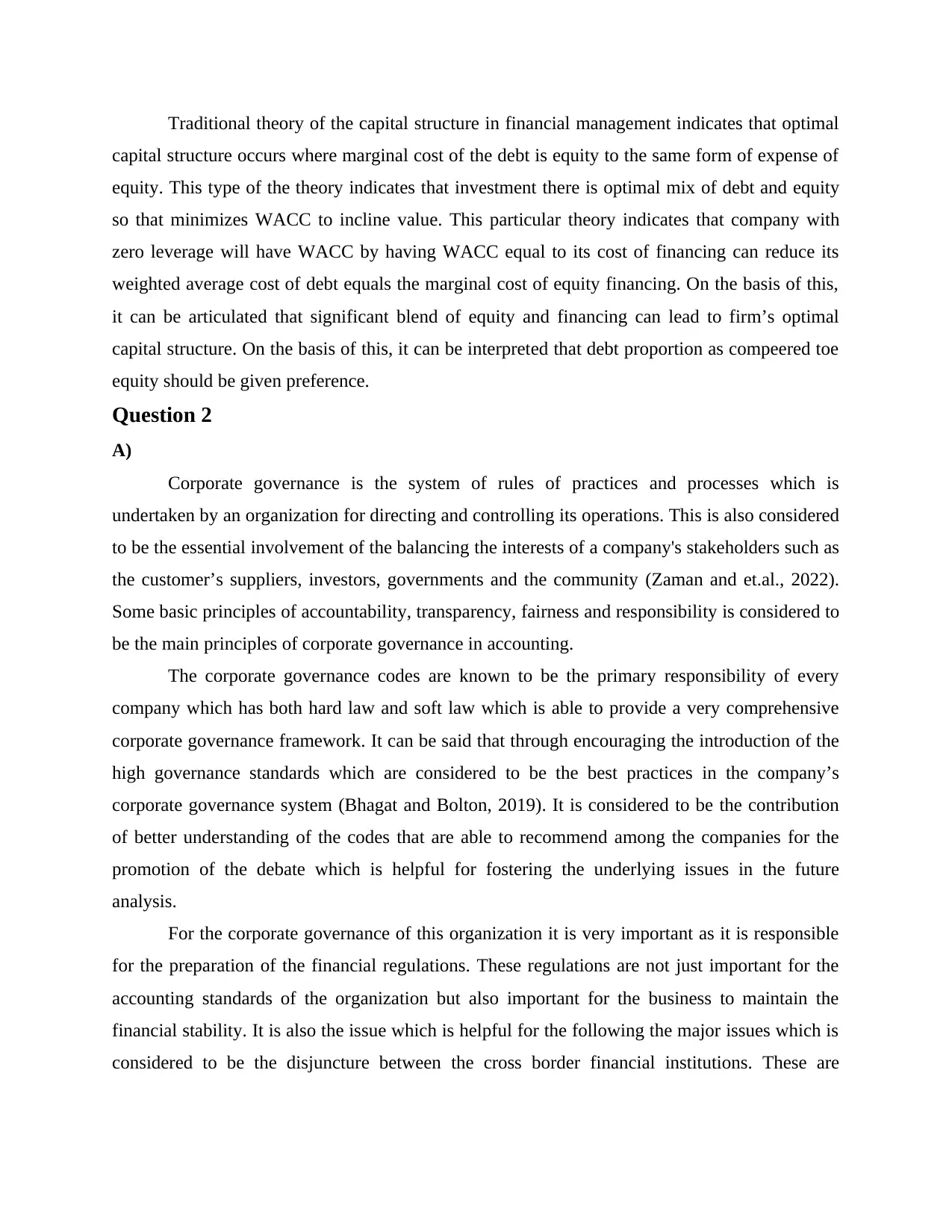
Traditional theory of the capital structure in financial management indicates that optimal
capital structure occurs where marginal cost of the debt is equity to the same form of expense of
equity. This type of the theory indicates that investment there is optimal mix of debt and equity
so that minimizes WACC to incline value. This particular theory indicates that company with
zero leverage will have WACC by having WACC equal to its cost of financing can reduce its
weighted average cost of debt equals the marginal cost of equity financing. On the basis of this,
it can be articulated that significant blend of equity and financing can lead to firm’s optimal
capital structure. On the basis of this, it can be interpreted that debt proportion as compeered toe
equity should be given preference.
Question 2
A)
Corporate governance is the system of rules of practices and processes which is
undertaken by an organization for directing and controlling its operations. This is also considered
to be the essential involvement of the balancing the interests of a company's stakeholders such as
the customer’s suppliers, investors, governments and the community (Zaman and et.al., 2022).
Some basic principles of accountability, transparency, fairness and responsibility is considered to
be the main principles of corporate governance in accounting.
The corporate governance codes are known to be the primary responsibility of every
company which has both hard law and soft law which is able to provide a very comprehensive
corporate governance framework. It can be said that through encouraging the introduction of the
high governance standards which are considered to be the best practices in the company’s
corporate governance system (Bhagat and Bolton, 2019). It is considered to be the contribution
of better understanding of the codes that are able to recommend among the companies for the
promotion of the debate which is helpful for fostering the underlying issues in the future
analysis.
For the corporate governance of this organization it is very important as it is responsible
for the preparation of the financial regulations. These regulations are not just important for the
accounting standards of the organization but also important for the business to maintain the
financial stability. It is also the issue which is helpful for the following the major issues which is
considered to be the disjuncture between the cross border financial institutions. These are
capital structure occurs where marginal cost of the debt is equity to the same form of expense of
equity. This type of the theory indicates that investment there is optimal mix of debt and equity
so that minimizes WACC to incline value. This particular theory indicates that company with
zero leverage will have WACC by having WACC equal to its cost of financing can reduce its
weighted average cost of debt equals the marginal cost of equity financing. On the basis of this,
it can be articulated that significant blend of equity and financing can lead to firm’s optimal
capital structure. On the basis of this, it can be interpreted that debt proportion as compeered toe
equity should be given preference.
Question 2
A)
Corporate governance is the system of rules of practices and processes which is
undertaken by an organization for directing and controlling its operations. This is also considered
to be the essential involvement of the balancing the interests of a company's stakeholders such as
the customer’s suppliers, investors, governments and the community (Zaman and et.al., 2022).
Some basic principles of accountability, transparency, fairness and responsibility is considered to
be the main principles of corporate governance in accounting.
The corporate governance codes are known to be the primary responsibility of every
company which has both hard law and soft law which is able to provide a very comprehensive
corporate governance framework. It can be said that through encouraging the introduction of the
high governance standards which are considered to be the best practices in the company’s
corporate governance system (Bhagat and Bolton, 2019). It is considered to be the contribution
of better understanding of the codes that are able to recommend among the companies for the
promotion of the debate which is helpful for fostering the underlying issues in the future
analysis.
For the corporate governance of this organization it is very important as it is responsible
for the preparation of the financial regulations. These regulations are not just important for the
accounting standards of the organization but also important for the business to maintain the
financial stability. It is also the issue which is helpful for the following the major issues which is
considered to be the disjuncture between the cross border financial institutions. These are
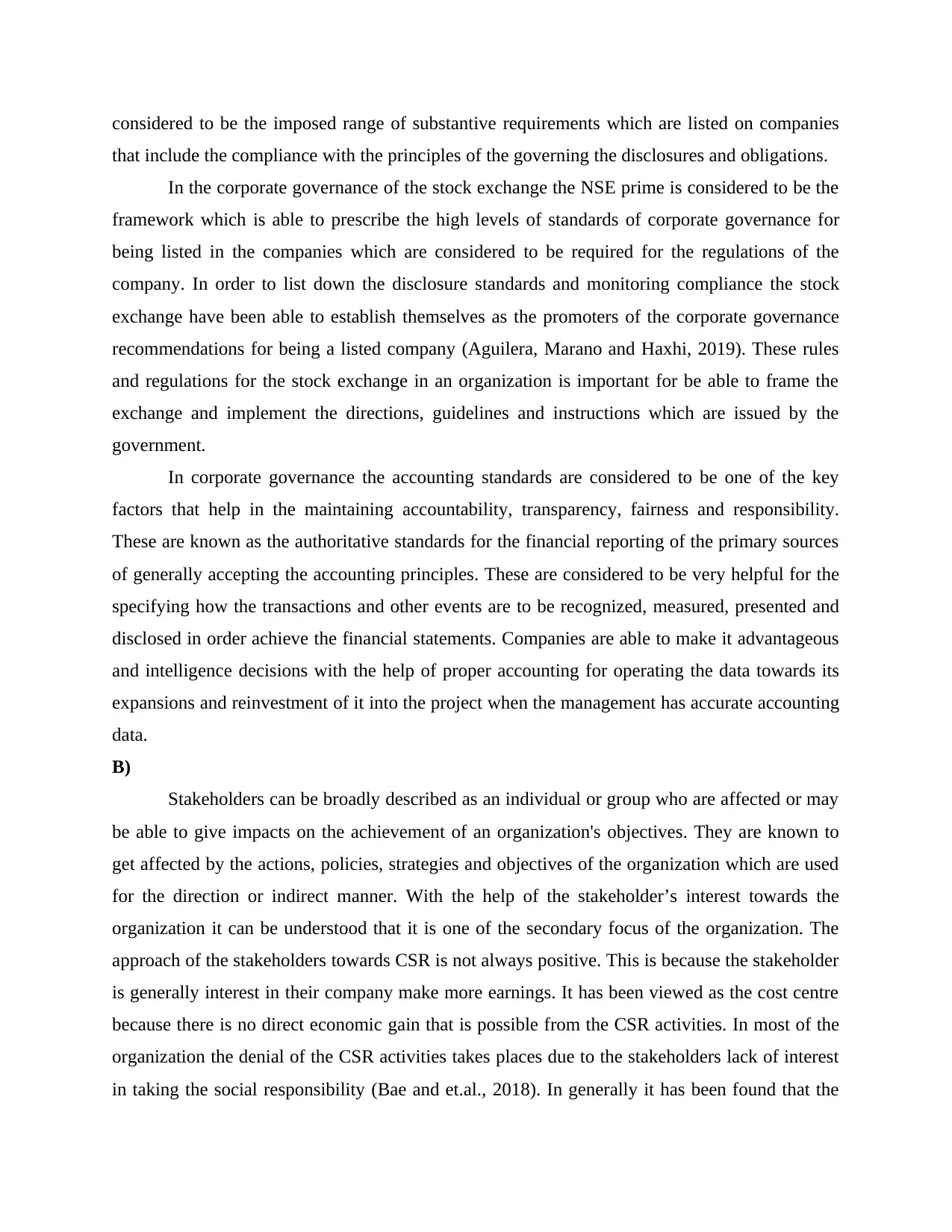
considered to be the imposed range of substantive requirements which are listed on companies
that include the compliance with the principles of the governing the disclosures and obligations.
In the corporate governance of the stock exchange the NSE prime is considered to be the
framework which is able to prescribe the high levels of standards of corporate governance for
being listed in the companies which are considered to be required for the regulations of the
company. In order to list down the disclosure standards and monitoring compliance the stock
exchange have been able to establish themselves as the promoters of the corporate governance
recommendations for being a listed company (Aguilera, Marano and Haxhi, 2019). These rules
and regulations for the stock exchange in an organization is important for be able to frame the
exchange and implement the directions, guidelines and instructions which are issued by the
government.
In corporate governance the accounting standards are considered to be one of the key
factors that help in the maintaining accountability, transparency, fairness and responsibility.
These are known as the authoritative standards for the financial reporting of the primary sources
of generally accepting the accounting principles. These are considered to be very helpful for the
specifying how the transactions and other events are to be recognized, measured, presented and
disclosed in order achieve the financial statements. Companies are able to make it advantageous
and intelligence decisions with the help of proper accounting for operating the data towards its
expansions and reinvestment of it into the project when the management has accurate accounting
data.
B)
Stakeholders can be broadly described as an individual or group who are affected or may
be able to give impacts on the achievement of an organization's objectives. They are known to
get affected by the actions, policies, strategies and objectives of the organization which are used
for the direction or indirect manner. With the help of the stakeholder’s interest towards the
organization it can be understood that it is one of the secondary focus of the organization. The
approach of the stakeholders towards CSR is not always positive. This is because the stakeholder
is generally interest in their company make more earnings. It has been viewed as the cost centre
because there is no direct economic gain that is possible from the CSR activities. In most of the
organization the denial of the CSR activities takes places due to the stakeholders lack of interest
in taking the social responsibility (Bae and et.al., 2018). In generally it has been found that the
that include the compliance with the principles of the governing the disclosures and obligations.
In the corporate governance of the stock exchange the NSE prime is considered to be the
framework which is able to prescribe the high levels of standards of corporate governance for
being listed in the companies which are considered to be required for the regulations of the
company. In order to list down the disclosure standards and monitoring compliance the stock
exchange have been able to establish themselves as the promoters of the corporate governance
recommendations for being a listed company (Aguilera, Marano and Haxhi, 2019). These rules
and regulations for the stock exchange in an organization is important for be able to frame the
exchange and implement the directions, guidelines and instructions which are issued by the
government.
In corporate governance the accounting standards are considered to be one of the key
factors that help in the maintaining accountability, transparency, fairness and responsibility.
These are known as the authoritative standards for the financial reporting of the primary sources
of generally accepting the accounting principles. These are considered to be very helpful for the
specifying how the transactions and other events are to be recognized, measured, presented and
disclosed in order achieve the financial statements. Companies are able to make it advantageous
and intelligence decisions with the help of proper accounting for operating the data towards its
expansions and reinvestment of it into the project when the management has accurate accounting
data.
B)
Stakeholders can be broadly described as an individual or group who are affected or may
be able to give impacts on the achievement of an organization's objectives. They are known to
get affected by the actions, policies, strategies and objectives of the organization which are used
for the direction or indirect manner. With the help of the stakeholder’s interest towards the
organization it can be understood that it is one of the secondary focus of the organization. The
approach of the stakeholders towards CSR is not always positive. This is because the stakeholder
is generally interest in their company make more earnings. It has been viewed as the cost centre
because there is no direct economic gain that is possible from the CSR activities. In most of the
organization the denial of the CSR activities takes places due to the stakeholders lack of interest
in taking the social responsibility (Bae and et.al., 2018). In generally it has been found that the
⊘ This is a preview!⊘
Do you want full access?
Subscribe today to unlock all pages.

Trusted by 1+ million students worldwide
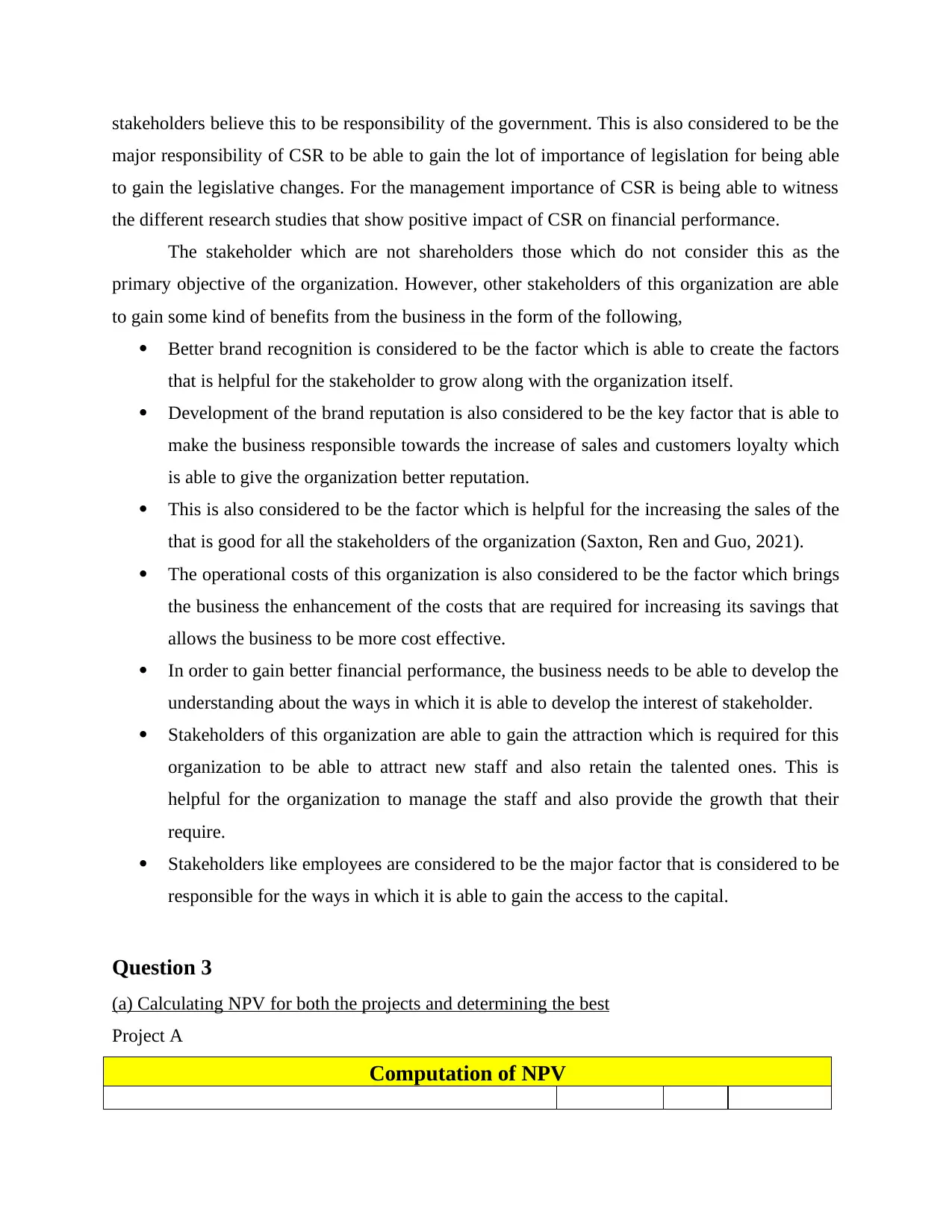
stakeholders believe this to be responsibility of the government. This is also considered to be the
major responsibility of CSR to be able to gain the lot of importance of legislation for being able
to gain the legislative changes. For the management importance of CSR is being able to witness
the different research studies that show positive impact of CSR on financial performance.
The stakeholder which are not shareholders those which do not consider this as the
primary objective of the organization. However, other stakeholders of this organization are able
to gain some kind of benefits from the business in the form of the following,
Better brand recognition is considered to be the factor which is able to create the factors
that is helpful for the stakeholder to grow along with the organization itself.
Development of the brand reputation is also considered to be the key factor that is able to
make the business responsible towards the increase of sales and customers loyalty which
is able to give the organization better reputation.
This is also considered to be the factor which is helpful for the increasing the sales of the
that is good for all the stakeholders of the organization (Saxton, Ren and Guo, 2021).
The operational costs of this organization is also considered to be the factor which brings
the business the enhancement of the costs that are required for increasing its savings that
allows the business to be more cost effective.
In order to gain better financial performance, the business needs to be able to develop the
understanding about the ways in which it is able to develop the interest of stakeholder.
Stakeholders of this organization are able to gain the attraction which is required for this
organization to be able to attract new staff and also retain the talented ones. This is
helpful for the organization to manage the staff and also provide the growth that their
require.
Stakeholders like employees are considered to be the major factor that is considered to be
responsible for the ways in which it is able to gain the access to the capital.
Question 3
(a) Calculating NPV for both the projects and determining the best
Project A
Computation of NPV
major responsibility of CSR to be able to gain the lot of importance of legislation for being able
to gain the legislative changes. For the management importance of CSR is being able to witness
the different research studies that show positive impact of CSR on financial performance.
The stakeholder which are not shareholders those which do not consider this as the
primary objective of the organization. However, other stakeholders of this organization are able
to gain some kind of benefits from the business in the form of the following,
Better brand recognition is considered to be the factor which is able to create the factors
that is helpful for the stakeholder to grow along with the organization itself.
Development of the brand reputation is also considered to be the key factor that is able to
make the business responsible towards the increase of sales and customers loyalty which
is able to give the organization better reputation.
This is also considered to be the factor which is helpful for the increasing the sales of the
that is good for all the stakeholders of the organization (Saxton, Ren and Guo, 2021).
The operational costs of this organization is also considered to be the factor which brings
the business the enhancement of the costs that are required for increasing its savings that
allows the business to be more cost effective.
In order to gain better financial performance, the business needs to be able to develop the
understanding about the ways in which it is able to develop the interest of stakeholder.
Stakeholders of this organization are able to gain the attraction which is required for this
organization to be able to attract new staff and also retain the talented ones. This is
helpful for the organization to manage the staff and also provide the growth that their
require.
Stakeholders like employees are considered to be the major factor that is considered to be
responsible for the ways in which it is able to gain the access to the capital.
Question 3
(a) Calculating NPV for both the projects and determining the best
Project A
Computation of NPV
Paraphrase This Document
Need a fresh take? Get an instant paraphrase of this document with our AI Paraphraser
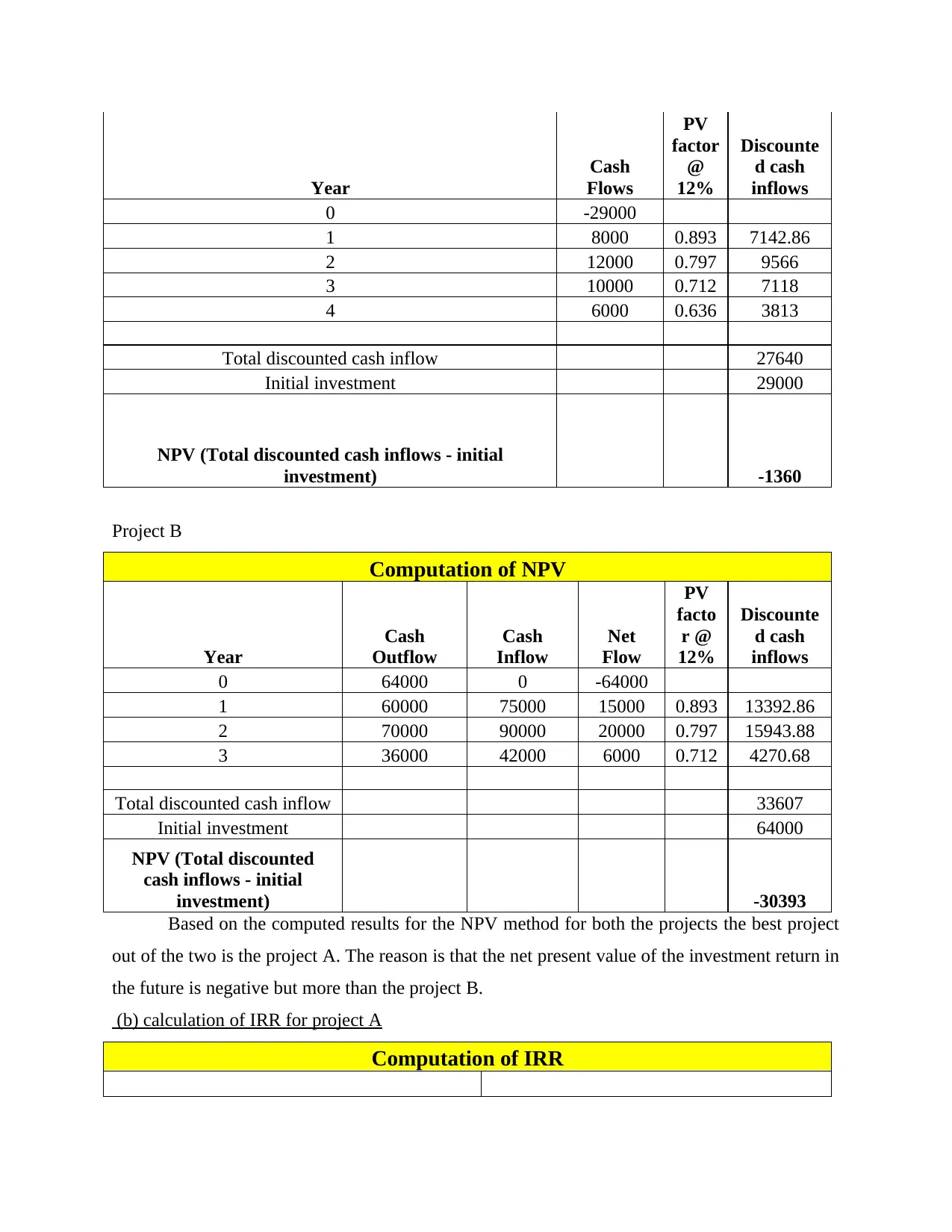
Year
Cash
Flows
PV
factor
@
12%
Discounte
d cash
inflows
0 -29000
1 8000 0.893 7142.86
2 12000 0.797 9566
3 10000 0.712 7118
4 6000 0.636 3813
Total discounted cash inflow 27640
Initial investment 29000
NPV (Total discounted cash inflows - initial
investment) -1360
Project B
Computation of NPV
Year
Cash
Outflow
Cash
Inflow
Net
Flow
PV
facto
r @
12%
Discounte
d cash
inflows
0 64000 0 -64000
1 60000 75000 15000 0.893 13392.86
2 70000 90000 20000 0.797 15943.88
3 36000 42000 6000 0.712 4270.68
Total discounted cash inflow 33607
Initial investment 64000
NPV (Total discounted
cash inflows - initial
investment) -30393
Based on the computed results for the NPV method for both the projects the best project
out of the two is the project A. The reason is that the net present value of the investment return in
the future is negative but more than the project B.
(b) calculation of IRR for project A
Computation of IRR
Cash
Flows
PV
factor
@
12%
Discounte
d cash
inflows
0 -29000
1 8000 0.893 7142.86
2 12000 0.797 9566
3 10000 0.712 7118
4 6000 0.636 3813
Total discounted cash inflow 27640
Initial investment 29000
NPV (Total discounted cash inflows - initial
investment) -1360
Project B
Computation of NPV
Year
Cash
Outflow
Cash
Inflow
Net
Flow
PV
facto
r @
12%
Discounte
d cash
inflows
0 64000 0 -64000
1 60000 75000 15000 0.893 13392.86
2 70000 90000 20000 0.797 15943.88
3 36000 42000 6000 0.712 4270.68
Total discounted cash inflow 33607
Initial investment 64000
NPV (Total discounted
cash inflows - initial
investment) -30393
Based on the computed results for the NPV method for both the projects the best project
out of the two is the project A. The reason is that the net present value of the investment return in
the future is negative but more than the project B.
(b) calculation of IRR for project A
Computation of IRR
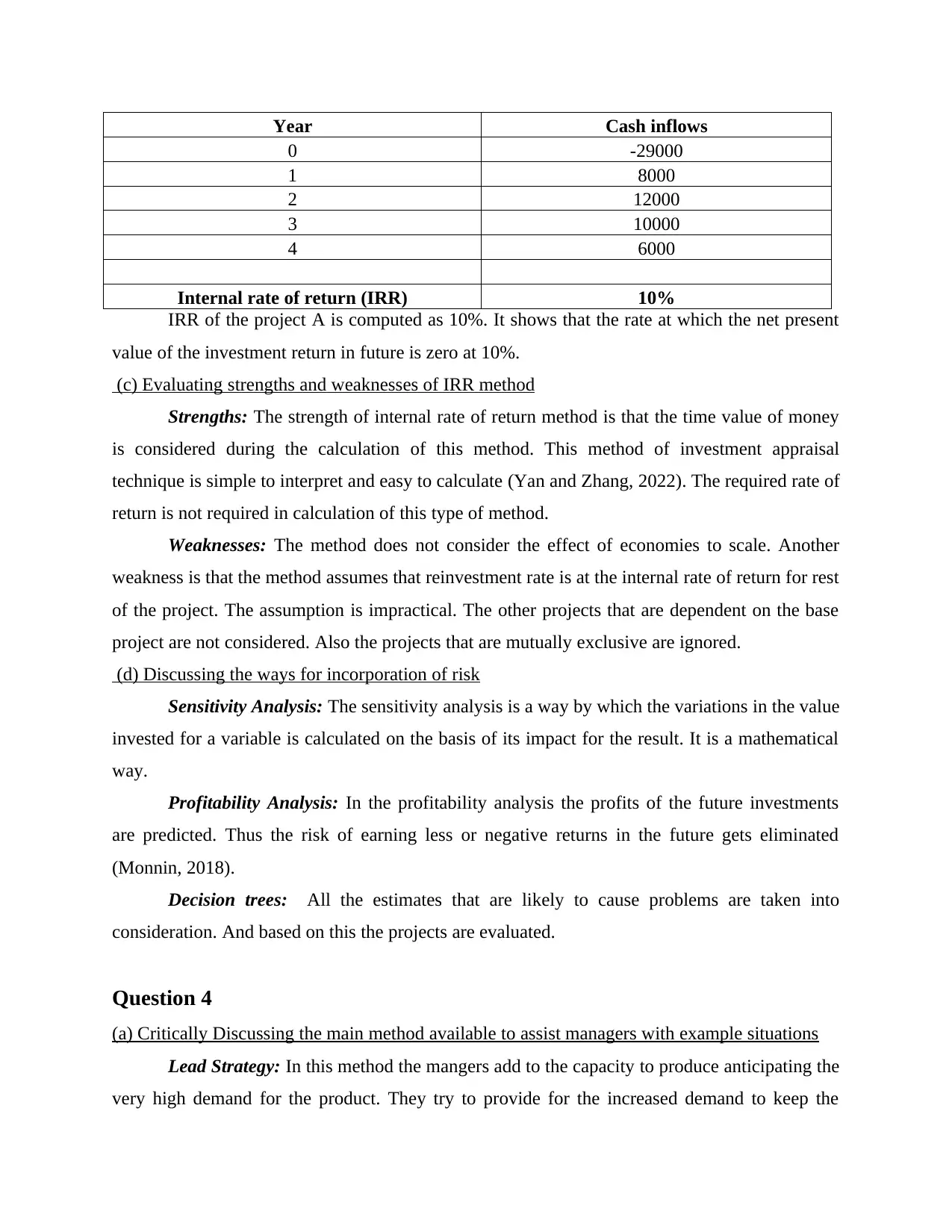
Year Cash inflows
0 -29000
1 8000
2 12000
3 10000
4 6000
Internal rate of return (IRR) 10%
IRR of the project A is computed as 10%. It shows that the rate at which the net present
value of the investment return in future is zero at 10%.
(c) Evaluating strengths and weaknesses of IRR method
Strengths: The strength of internal rate of return method is that the time value of money
is considered during the calculation of this method. This method of investment appraisal
technique is simple to interpret and easy to calculate (Yan and Zhang, 2022). The required rate of
return is not required in calculation of this type of method.
Weaknesses: The method does not consider the effect of economies to scale. Another
weakness is that the method assumes that reinvestment rate is at the internal rate of return for rest
of the project. The assumption is impractical. The other projects that are dependent on the base
project are not considered. Also the projects that are mutually exclusive are ignored.
(d) Discussing the ways for incorporation of risk
Sensitivity Analysis: The sensitivity analysis is a way by which the variations in the value
invested for a variable is calculated on the basis of its impact for the result. It is a mathematical
way.
Profitability Analysis: In the profitability analysis the profits of the future investments
are predicted. Thus the risk of earning less or negative returns in the future gets eliminated
(Monnin, 2018).
Decision trees: All the estimates that are likely to cause problems are taken into
consideration. And based on this the projects are evaluated.
Question 4
(a) Critically Discussing the main method available to assist managers with example situations
Lead Strategy: In this method the mangers add to the capacity to produce anticipating the
very high demand for the product. They try to provide for the increased demand to keep the
0 -29000
1 8000
2 12000
3 10000
4 6000
Internal rate of return (IRR) 10%
IRR of the project A is computed as 10%. It shows that the rate at which the net present
value of the investment return in future is zero at 10%.
(c) Evaluating strengths and weaknesses of IRR method
Strengths: The strength of internal rate of return method is that the time value of money
is considered during the calculation of this method. This method of investment appraisal
technique is simple to interpret and easy to calculate (Yan and Zhang, 2022). The required rate of
return is not required in calculation of this type of method.
Weaknesses: The method does not consider the effect of economies to scale. Another
weakness is that the method assumes that reinvestment rate is at the internal rate of return for rest
of the project. The assumption is impractical. The other projects that are dependent on the base
project are not considered. Also the projects that are mutually exclusive are ignored.
(d) Discussing the ways for incorporation of risk
Sensitivity Analysis: The sensitivity analysis is a way by which the variations in the value
invested for a variable is calculated on the basis of its impact for the result. It is a mathematical
way.
Profitability Analysis: In the profitability analysis the profits of the future investments
are predicted. Thus the risk of earning less or negative returns in the future gets eliminated
(Monnin, 2018).
Decision trees: All the estimates that are likely to cause problems are taken into
consideration. And based on this the projects are evaluated.
Question 4
(a) Critically Discussing the main method available to assist managers with example situations
Lead Strategy: In this method the mangers add to the capacity to produce anticipating the
very high demand for the product. They try to provide for the increased demand to keep the
⊘ This is a preview!⊘
Do you want full access?
Subscribe today to unlock all pages.

Trusted by 1+ million students worldwide
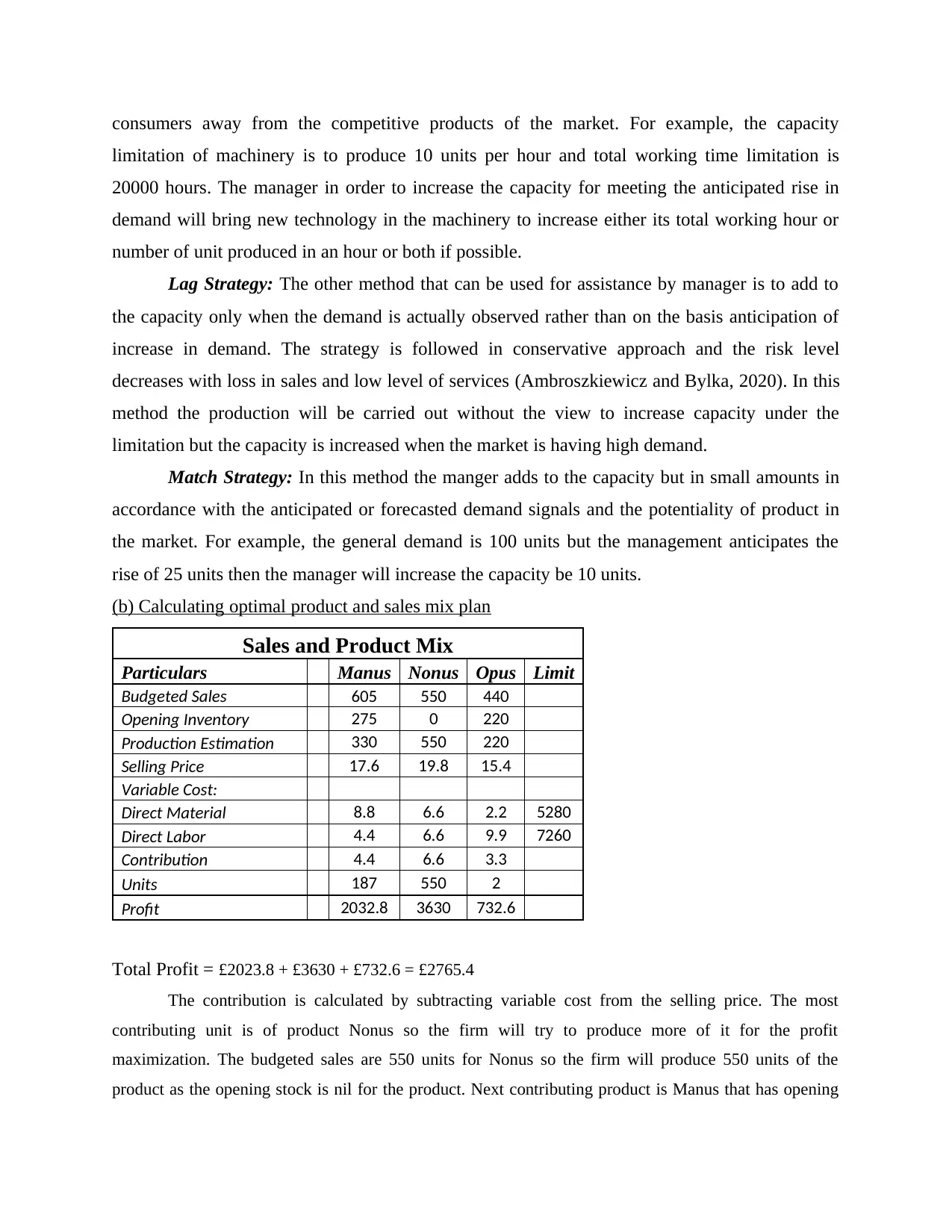
consumers away from the competitive products of the market. For example, the capacity
limitation of machinery is to produce 10 units per hour and total working time limitation is
20000 hours. The manager in order to increase the capacity for meeting the anticipated rise in
demand will bring new technology in the machinery to increase either its total working hour or
number of unit produced in an hour or both if possible.
Lag Strategy: The other method that can be used for assistance by manager is to add to
the capacity only when the demand is actually observed rather than on the basis anticipation of
increase in demand. The strategy is followed in conservative approach and the risk level
decreases with loss in sales and low level of services (Ambroszkiewicz and Bylka, 2020). In this
method the production will be carried out without the view to increase capacity under the
limitation but the capacity is increased when the market is having high demand.
Match Strategy: In this method the manger adds to the capacity but in small amounts in
accordance with the anticipated or forecasted demand signals and the potentiality of product in
the market. For example, the general demand is 100 units but the management anticipates the
rise of 25 units then the manager will increase the capacity be 10 units.
(b) Calculating optimal product and sales mix plan
Sales and Product Mix
Particulars Manus Nonus Opus Limit
Budgeted Sales 605 550 440
Opening Inventory 275 0 220
Production Estimation 330 550 220
Selling Price 17.6 19.8 15.4
Variable Cost:
Direct Material 8.8 6.6 2.2 5280
Direct Labor 4.4 6.6 9.9 7260
Contribution 4.4 6.6 3.3
Units 187 550 2
Profit 2032.8 3630 732.6
Total Profit = £2023.8 + £3630 + £732.6 = £2765.4
The contribution is calculated by subtracting variable cost from the selling price. The most
contributing unit is of product Nonus so the firm will try to produce more of it for the profit
maximization. The budgeted sales are 550 units for Nonus so the firm will produce 550 units of the
product as the opening stock is nil for the product. Next contributing product is Manus that has opening
limitation of machinery is to produce 10 units per hour and total working time limitation is
20000 hours. The manager in order to increase the capacity for meeting the anticipated rise in
demand will bring new technology in the machinery to increase either its total working hour or
number of unit produced in an hour or both if possible.
Lag Strategy: The other method that can be used for assistance by manager is to add to
the capacity only when the demand is actually observed rather than on the basis anticipation of
increase in demand. The strategy is followed in conservative approach and the risk level
decreases with loss in sales and low level of services (Ambroszkiewicz and Bylka, 2020). In this
method the production will be carried out without the view to increase capacity under the
limitation but the capacity is increased when the market is having high demand.
Match Strategy: In this method the manger adds to the capacity but in small amounts in
accordance with the anticipated or forecasted demand signals and the potentiality of product in
the market. For example, the general demand is 100 units but the management anticipates the
rise of 25 units then the manager will increase the capacity be 10 units.
(b) Calculating optimal product and sales mix plan
Sales and Product Mix
Particulars Manus Nonus Opus Limit
Budgeted Sales 605 550 440
Opening Inventory 275 0 220
Production Estimation 330 550 220
Selling Price 17.6 19.8 15.4
Variable Cost:
Direct Material 8.8 6.6 2.2 5280
Direct Labor 4.4 6.6 9.9 7260
Contribution 4.4 6.6 3.3
Units 187 550 2
Profit 2032.8 3630 732.6
Total Profit = £2023.8 + £3630 + £732.6 = £2765.4
The contribution is calculated by subtracting variable cost from the selling price. The most
contributing unit is of product Nonus so the firm will try to produce more of it for the profit
maximization. The budgeted sales are 550 units for Nonus so the firm will produce 550 units of the
product as the opening stock is nil for the product. Next contributing product is Manus that has opening
Paraphrase This Document
Need a fresh take? Get an instant paraphrase of this document with our AI Paraphraser
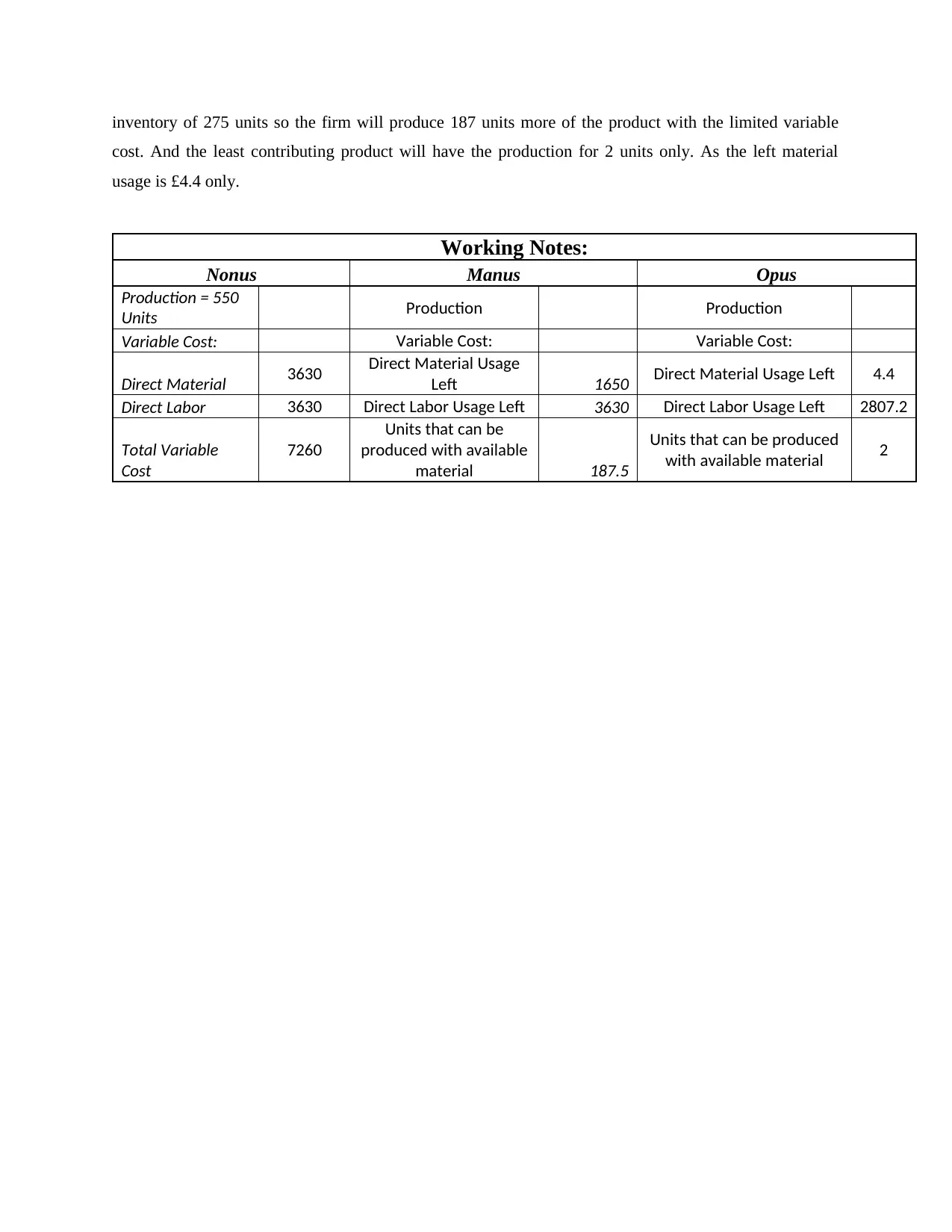
inventory of 275 units so the firm will produce 187 units more of the product with the limited variable
cost. And the least contributing product will have the production for 2 units only. As the left material
usage is £4.4 only.
Working Notes:
Nonus Manus Opus
Production = 550
Units Production Production
Variable Cost: Variable Cost: Variable Cost:
Direct Material 3630 Direct Material Usage
Left 1650 Direct Material Usage Left 4.4
Direct Labor 3630 Direct Labor Usage Left 3630 Direct Labor Usage Left 2807.2
Total Variable
Cost
7260
Units that can be
produced with available
material 187.5
Units that can be produced
with available material 2
cost. And the least contributing product will have the production for 2 units only. As the left material
usage is £4.4 only.
Working Notes:
Nonus Manus Opus
Production = 550
Units Production Production
Variable Cost: Variable Cost: Variable Cost:
Direct Material 3630 Direct Material Usage
Left 1650 Direct Material Usage Left 4.4
Direct Labor 3630 Direct Labor Usage Left 3630 Direct Labor Usage Left 2807.2
Total Variable
Cost
7260
Units that can be
produced with available
material 187.5
Units that can be produced
with available material 2
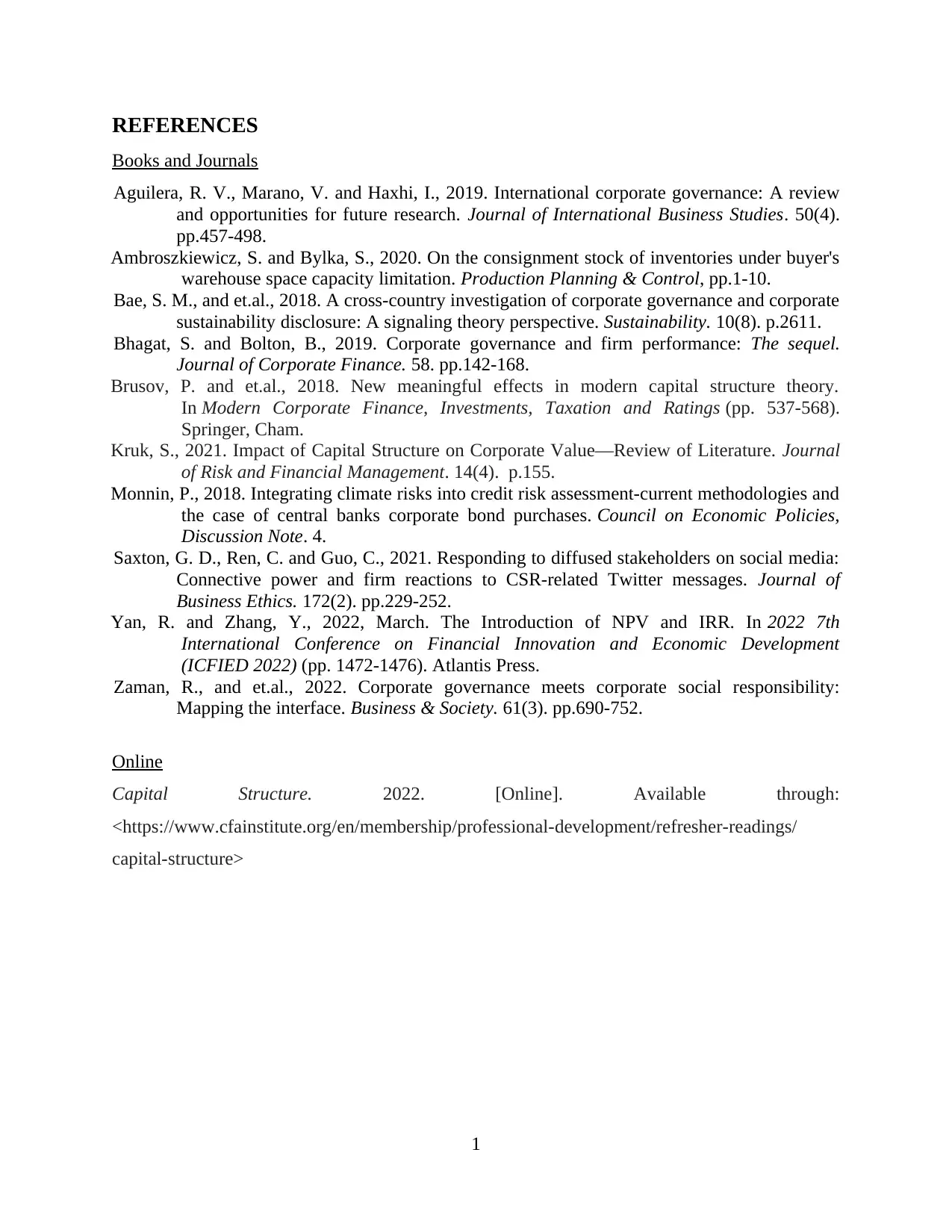
REFERENCES
Books and Journals
Aguilera, R. V., Marano, V. and Haxhi, I., 2019. International corporate governance: A review
and opportunities for future research. Journal of International Business Studies. 50(4).
pp.457-498.
Ambroszkiewicz, S. and Bylka, S., 2020. On the consignment stock of inventories under buyer's
warehouse space capacity limitation. Production Planning & Control, pp.1-10.
Bae, S. M., and et.al., 2018. A cross-country investigation of corporate governance and corporate
sustainability disclosure: A signaling theory perspective. Sustainability. 10(8). p.2611.
Bhagat, S. and Bolton, B., 2019. Corporate governance and firm performance: The sequel.
Journal of Corporate Finance. 58. pp.142-168.
Brusov, P. and et.al., 2018. New meaningful effects in modern capital structure theory.
In Modern Corporate Finance, Investments, Taxation and Ratings (pp. 537-568).
Springer, Cham.
Kruk, S., 2021. Impact of Capital Structure on Corporate Value—Review of Literature. Journal
of Risk and Financial Management. 14(4). p.155.
Monnin, P., 2018. Integrating climate risks into credit risk assessment-current methodologies and
the case of central banks corporate bond purchases. Council on Economic Policies,
Discussion Note. 4.
Saxton, G. D., Ren, C. and Guo, C., 2021. Responding to diffused stakeholders on social media:
Connective power and firm reactions to CSR-related Twitter messages. Journal of
Business Ethics. 172(2). pp.229-252.
Yan, R. and Zhang, Y., 2022, March. The Introduction of NPV and IRR. In 2022 7th
International Conference on Financial Innovation and Economic Development
(ICFIED 2022) (pp. 1472-1476). Atlantis Press.
Zaman, R., and et.al., 2022. Corporate governance meets corporate social responsibility:
Mapping the interface. Business & Society. 61(3). pp.690-752.
Online
Capital Structure. 2022. [Online]. Available through:
<https://www.cfainstitute.org/en/membership/professional-development/refresher-readings/
capital-structure>
1
Books and Journals
Aguilera, R. V., Marano, V. and Haxhi, I., 2019. International corporate governance: A review
and opportunities for future research. Journal of International Business Studies. 50(4).
pp.457-498.
Ambroszkiewicz, S. and Bylka, S., 2020. On the consignment stock of inventories under buyer's
warehouse space capacity limitation. Production Planning & Control, pp.1-10.
Bae, S. M., and et.al., 2018. A cross-country investigation of corporate governance and corporate
sustainability disclosure: A signaling theory perspective. Sustainability. 10(8). p.2611.
Bhagat, S. and Bolton, B., 2019. Corporate governance and firm performance: The sequel.
Journal of Corporate Finance. 58. pp.142-168.
Brusov, P. and et.al., 2018. New meaningful effects in modern capital structure theory.
In Modern Corporate Finance, Investments, Taxation and Ratings (pp. 537-568).
Springer, Cham.
Kruk, S., 2021. Impact of Capital Structure on Corporate Value—Review of Literature. Journal
of Risk and Financial Management. 14(4). p.155.
Monnin, P., 2018. Integrating climate risks into credit risk assessment-current methodologies and
the case of central banks corporate bond purchases. Council on Economic Policies,
Discussion Note. 4.
Saxton, G. D., Ren, C. and Guo, C., 2021. Responding to diffused stakeholders on social media:
Connective power and firm reactions to CSR-related Twitter messages. Journal of
Business Ethics. 172(2). pp.229-252.
Yan, R. and Zhang, Y., 2022, March. The Introduction of NPV and IRR. In 2022 7th
International Conference on Financial Innovation and Economic Development
(ICFIED 2022) (pp. 1472-1476). Atlantis Press.
Zaman, R., and et.al., 2022. Corporate governance meets corporate social responsibility:
Mapping the interface. Business & Society. 61(3). pp.690-752.
Online
Capital Structure. 2022. [Online]. Available through:
<https://www.cfainstitute.org/en/membership/professional-development/refresher-readings/
capital-structure>
1
⊘ This is a preview!⊘
Do you want full access?
Subscribe today to unlock all pages.

Trusted by 1+ million students worldwide
1 out of 12
Related Documents
Your All-in-One AI-Powered Toolkit for Academic Success.
+13062052269
info@desklib.com
Available 24*7 on WhatsApp / Email
![[object Object]](/_next/static/media/star-bottom.7253800d.svg)
Unlock your academic potential
Copyright © 2020–2025 A2Z Services. All Rights Reserved. Developed and managed by ZUCOL.




